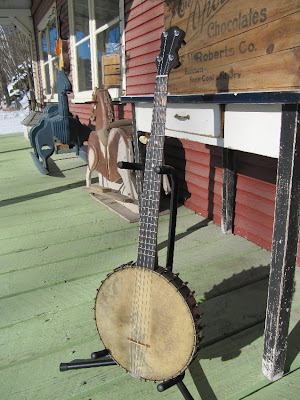c.1900 Lyon & Healy 5-String Banjo

Here's what I like to see in an antique banjo! This is a well-used but not very abused old 5-string, intended for gut (here with Nylgut strings), with an 11" spunover pot. For those not in the know, that means the pot is 1-ply of hardwood wrapped in a brass nickel-silver plated shell, with the top and bottom of the pot having the brass curled or rolled-over. This generates an integral "tone ring" at the top of the rim which boosts volume and clarity. As expected, this has a boomy bottom end with sweet trebles... and it's loud for a gut-stringer, too!

This banjo was made by Lyon & Healy c.1900 or so, and this headstock is their typical shape at the time. It originally would have had wood or bone pegs but they were missing, so I added in modern friction pegs which work just dandy with the Nylgut strings. The nut is new, and cut from the remains of one of those high-tech plastics they used in saddles in the 1960s.

Original frets are all there, and the thin ebony board is worn with loads of honest play-wear, right down to the neck wood. MOP dots. Note the interesting wooden "nut" for the 5th string -- this is not original and is probably a pretty old adaptation. When I repaired a crack at this section I had that 5th string "nut" area off the neck and saw the hole under the fretboard that was drilled for (what was typical then) a tiny screw that the string would have passed through.

...

Head is original and skin. Sounds good, too!

This bridge is a c.1920s two-foot tenor banjo bridge that I cut the ebony off of. It had warped on the tenor over time, but a recut top leaves it nice and sturdy and lightweight and sans a top wood, meaning it's perfect for gut strings.

All the hardware on the rim is original save one hook & nut. It's a 30-hook rim.

...

Back. Definitely an elegant design.

Peghead rear.

Here's the crack I repaired. I infused a bunch of glue into it and then clamped it all up. It's just as sturdy as if it were never there, now. These cracks are typical when someone unskilled "in the art" tries to install a 5th-string friction peg. It's a very shallow crack and mostly in the surface, but it's frustrating to see this. Remember this when you're thinking of knocking a peg into a neck and you're not sure about what you're doing!

Nice, slim, elegant "boat heel." I think these feel wonderful and I wish more modern builders took this approach. It's much more organic and feels great when you're playing up the neck.

Back.

...

...

1920s-era Waverly tenor banjo tailpiece. The original for this banjo was missing so I used this fellow -- it happens to have just the right number of cuts to make it work perfectly with the knotted ends of the strings.

Neck join is reinforced by two screws into the heel. Typical for the time.

And here you can see that spunover rim. Really lovely, simple construction. I always like the sound of banjos built like this.

Comments